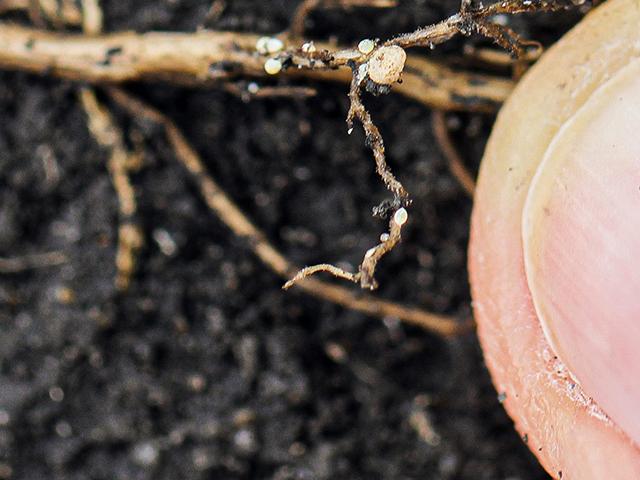Croplink
Do a Mid-Season SCN Check
It's a good time of year to sneak up on soybean cyst nematode (SCN). North Dakota State University plant pathologist Sam Markell says it is possible to visually spot females feeding on soybean roots.
While testing is typically done in the fall, these in-season spot-checks provide a good clue as to the numbers in your field and whether past controls are working to get SCN levels down.
Grab a shovel or a hand trowel, and dig the plant and surrounding roots. "Those small, white-colored females are only loosely attached where they feed on the root, so pulling the plant tends to knock them off," Markell says. "Depending on how dry the soil is, I will sometimes take a 5-gallon bucket of water to the field and carefully wash the soil off the roots."
P[L1] D[0x0] M[300x250] OOP[F] ADUNIT[] T[]
What you are looking for are small white or cream-colored, pin-sized dots that are typically much smaller than a healthy soybean nodule. A flashlight and hand lens can also be helpful in the search.
Markell says females will swell with 100 to 200 eggs, and they may go through multiple life cycles, depending on region of the country. North Dakota may have two to three generations, for example, while Missouri has three to six, he explains.
"Each time they go through one of these generations, the levels are increasing in the field," Markell adds. "If you are planting a resistant variety and spotting a lot of white females in-season, it likely means that variety is not holding up under SCN pressure very well."
It's also a clue the field needs a serious soil-testing program to identify what levels are present and create a management program using different sources of resistance and/or treatments to start reducing SCN levels to try to control yield loss. "Effective SCN management starts by knowing your numbers," he says.
**
-- Find videos and other SCN management info at www.thescncoalition.com
-- Follow the latest from Pamela Smith, Crops Technology Editor, by visiting the Production Blogs at dtnpf.com or following her on Twitter @PamSmithDTN
[PF_0821]
(c) Copyright 2021 DTN, LLC. All rights reserved.



